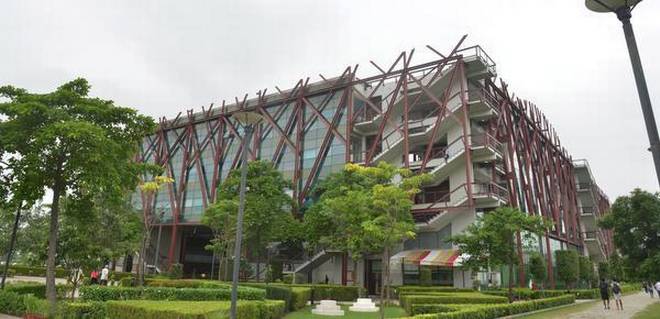Now, India and Pakistan share vision of history
By Kallol Bhattacherjee
The Hindu : May 20, 2018

Forging links: The O.P. Jindal Global University at Sonipat in Haryana. | Photo Credit: R. V. Moorthy
An undergraduate course prepared by academicians on both sides of the border looks beyond ‘official’ interpretations
The hostility between India and Pakistan manifests itself in the contradictory understanding of South Asian history, which disagrees on individuals and episodes related to it.
Pitching for a change in this attitude, two educational institutes of the region have managed to create a common academic course in ‘shared South Asian history.’
The O.P. Jindal Global University (OPJGU) and the Lahore University of Management Sciences (LUMS), earlier in 2017, prepared and began a course covering important historical landmarks and personalities in modern Indian and Pakistani history.
As a result, Dr. Pallavi Raghavan of OPJGU and Dr. Ali Usman Qasemi of LUMS, on two sides of the border, came up with ‘Foundations of South Asian History,’ an undergraduate course for students of their respective universities.
The title made it clear that there could be more than one foundation for the South Asian region. It dealt with issues that usually are lost in the highly politicised study of historical figures like Mohammed Ali Jinnah and Mahatma Gandhi.
A key feature of the course is the study of aspects like the Indus Valley Civilisation, the core of which lies in Pakistan but does not get highlighted in official history of the state, as it de-emphasises ancient history of the Af-Pak region and highlights the advent of Islam in South Asia.
So, from the official Pakistani historical perspective, the real history of the two-nation theory begins with the arrival of Islamic conqueror Mohammed Bin Qasim to Sindh in the 7th century AD. Similarly, in the Indian context, figures like Pakistan’s founder ‘Qaid-e-Azam’ Jinnah and the first Prime Minister of Pakistan Liaquat Ali Khan are considered to be polarising figures. That apart, various historical phases like the resistance against 19th century colonialism, which is usually interpreted in both India and Pakistan in contradictory ways, formed a major challenge.
Dr. Ali Usman Qasemi explained, “What is remarkable about the course is that it gives an opportunity to students to study a shared but highly contested past. The idea is that students from Lahore and Delhi would discuss South Asian historical processes that impact our present day state, society and politics.”
At the heart of framing the course was the task of removing the narrower perspective of ‘official history’ that is delivered by academic structures on both sides of the India-Pakistan border, said Ms. Raghavan who, like Dr. Qasemi, is a trained historian.
Common understanding
“School textbooks blinker the student’s sense of the past and the course was aimed at building a common understanding of South Asian history,” Ms. Raghavan said, explaining the framing of the course by Dr. Qasemi and herself.
The initial process of teaching had to address the limited or negative understanding of figures like Jinnah, and Chaudhary Rahmat Ali among the Indian students and the similarly near-absent understanding of Rabindranath Tagore and Dr. B.R. Ambedkar among their Pakistani counterparts. “In fact, Pakistani students had a minimal idea about Ambedkar’s contribution to India,” Ms. Raghavan said.
Swaroopananda Mishra, a student of law who opted for the paper, said that as an optional paper it drew good response from scholars in multiple courses, including that of law. The course therefore had a substantial reading list of primary texts. A. L. Basham, Irfan Habib, Satish Chandra are among the recommended authors. Each reading addresses the controversies that are listed in a segment. For example, the chapter on the Indus Valley Civilisation had to deal with the controversial theory of ‘Aryan invasion’ and the chapter on Mughal history had to deal with the controversial perspective of ‘Muslimness’ of the Mughal empire. In the chapter on early Muslim history, the issue of the alleged massacre of Hindus was taken up. The goal of the course was not just to impart factual information on history, but also to ensure a deeper understanding of historical processes and dynamics. Students have to study 29 such segments dealing with 27 contested topics.
Complete autonomy
In all, the Indian batch of the subject had eight students and the Pakistani batch had 16 students. Upon completion, students will get credits that will support their overall grades. Pallavi Raghavan says that the unique academic exercise for graduate students was possible because they had complete autonomy in preparing such a course.
Similar attempts have not succeeded elsewhere. Notably, in the Delhi-based South Asian University (SAU), a course on history has so far not been implemented as member countries of the South Asian Association for Regional Cooperation (SAARC) region failed to come to a consensus on key events and narratives.
The challenge was, therefore, to craft a course where conversation could flow. Students on both sides connected through Skype could learn from faculty members and visiting lecturers, interact with each other and do collaborative course work over email and WhatsApp.
After a semester of studying through Skype and doing collaborative work, the students from Pakistan joined their Indian counterparts at OPJGU on 11 May for a physical class room experience. It was the satisfying culmination of nearly a year of effort by faculty members and visiting lecturers like Mani Shankar Aiyar, Srinath Raghavan and Meenakshi Gopinath.
The last class of the paper, which took place against the backdrop of the controversy over the portrait of Jinnah in the Aligarh Muslim University campus, provided a lively context, when 11 Pakistani students finally managed to get the visa to travel to the physical classroom in OPJGU.